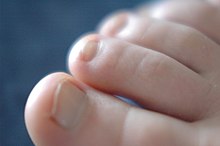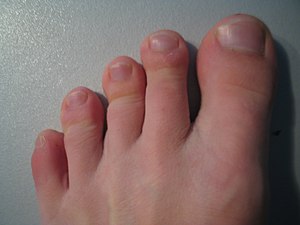tå
Danish
[edit]Etymology
[edit]Pronunciation
[edit]Noun
[edit]tå c (singular definite tåen, plural indefinite tæer)
- toe (part of a foot; also part of a sock, stocking or shoe)
Inflection
[edit]Derived terms
[edit]Norwegian Bokmål
[edit]Etymology
[edit]Noun
[edit]tå f or m (definite singular tåa or tåen, indefinite plural tær, definite plural tærne)
- a toe (part of a foot; also part of a sock, stocking or shoe)
Derived terms
[edit]References
[edit]- “tå” in The Bokmål Dictionary.
Norwegian Nynorsk
[edit]Etymology 1
[edit]
From Old Norse tá, from Proto-Germanic *taihwǭ. from the Proto-Indo-European root *deyḱ- (“to point out”). Cognate with Latin digitus.
Alternative forms
[edit]Noun
[edit]tå f (definite singular tåa, indefinite plural tær, definite plural tærne)
- a toe (part of a foot; also part of a sock, stocking or shoe)
Derived terms
[edit]Etymology 2
[edit]From Old Norse þá, from Proto-Germanic *þawō. Related to the verb tø (from Old Norse þeyja). Related to English thaw.
Noun
[edit]tå f (definite singular tåa, indefinite plural tåer, definite plural tåene)
Adjective
[edit]tå (neuter singular tått, definite singular and plural tå or tåe, comparative tåare, indefinite superlative tåast, definite superlative tåaste)
Derived terms
[edit]Etymology 3
[edit]There is a suspected relation to tæ and teia, from Proto-Norse ᛏᚨᚹᛁᛞᛟ (tawido, “I made”), from Proto-Germanic *tawjaną.
Verb
[edit]tå (present tense tår, past tense tådde, past participle tått/tådd, passive infinitive tåast, present participle tåande, imperative tå)
- (transitive) to pick apart, dissolve
Etymology 4
[edit]Aasen, in his 1850 dictionary, lists it as a variant of ut av.[1][2] As such, the origin of this word is not too dissimilar from that of på (“on”) from Old Norse upp á. See also tu and poinni.
Alternative forms
[edit]Preposition
[edit]tå
- (dialectal, Trøndelag, Eastern Norway) Nonstandard form of av.
- Æ skjønne itj bæra tå det som stend ti paperom
- I don't understand a word of what is written in the papers
- 2018, NDL (lyrics and music), “Morgan Cockaine”, in Demo:
- Æ drømme' mæ bort i dokkers røyk tå krutt, sjarm og ildvann.
- I'm dreaming me away in your's smoke of gunpowder, charme and firewater
- Æ skjønne itj bæra tå det som stend ti paperom
Adverb
[edit]tå
- (dialectal) Nonstandard form of av.
References
[edit]- “tå” in The Nynorsk Dictionary.
- ^ Ivar Aasen (1850) “taa”, in Ordbog over det norske Folkesprog[1] (in Danish), Oslo: Samlaget, published 2000
- ^ Ivar Aasen (1850) “ut-av”, in Ordbog over det norske Folkesprog[2] (in Danish), Oslo: Samlaget, published 2000
Anagrams
[edit]Swedish
[edit]
Etymology
[edit]From Old Swedish ta, from Old Norse tá, from Proto-Germanic *taihwǭ, from Proto-Indo-European *deyḱ-.
Pronunciation
[edit]Noun
[edit]tå c
Inflection
[edit]| Declension of tå | ||||
|---|---|---|---|---|
| Singular | Plural | |||
| Indefinite | Definite | Indefinite | Definite | |
| Nominative | tå | tån | tår | tårna |
| Genitive | tås | tåns | tårs | tårnas |
Derived terms
[edit]See also
[edit]References
[edit]- tå in Svensk ordbok (SO)
- tå in Svenska Akademiens ordlista (SAOL)
- tå in Svenska Akademiens ordbok (SAOB)
- Svensk MeSH
Anagrams
[edit]Tircul
[edit]Pronunciation
[edit]Numeral
[edit]See also
[edit]- Danish terms derived from Proto-Indo-European
- Danish terms derived from the Proto-Indo-European root *deyḱ-
- Danish terms derived from Old Norse
- Danish terms with IPA pronunciation
- Danish lemmas
- Danish nouns
- Danish common-gender nouns
- Norwegian Bokmål terms derived from Proto-Indo-European
- Norwegian Bokmål terms derived from the Proto-Indo-European root *deyḱ-
- Norwegian Bokmål terms derived from Old Norse
- Norwegian Bokmål lemmas
- Norwegian Bokmål nouns
- Norwegian Bokmål feminine nouns
- Norwegian Bokmål masculine nouns
- Norwegian Bokmål nouns with multiple genders
- nb:Anatomy
- Norwegian Nynorsk terms derived from Proto-Indo-European
- Norwegian Nynorsk terms derived from the Proto-Indo-European root *deyḱ-
- Norwegian Nynorsk terms inherited from Old Norse
- Norwegian Nynorsk terms derived from Old Norse
- Norwegian Nynorsk terms inherited from Proto-Germanic
- Norwegian Nynorsk terms derived from Proto-Germanic
- Norwegian Nynorsk lemmas
- Norwegian Nynorsk nouns
- Norwegian Nynorsk feminine nouns
- Norwegian Nynorsk adjectives
- Norwegian Nynorsk terms derived from Proto-Norse
- Norwegian Nynorsk verbs
- Norwegian Nynorsk weak verbs
- Norwegian Nynorsk transitive verbs
- Norwegian Nynorsk prepositions
- Norwegian Nynorsk dialectal terms
- Trøndersk Norwegian
- Norwegian Nynorsk nonstandard forms
- Norwegian Nynorsk terms with quotations
- Norwegian Nynorsk adverbs
- nn:Anatomy
- Swedish terms derived from Proto-Indo-European
- Swedish terms derived from the Proto-Indo-European root *deyḱ-
- Swedish terms inherited from Old Swedish
- Swedish terms derived from Old Swedish
- Swedish terms inherited from Old Norse
- Swedish terms derived from Old Norse
- Swedish terms inherited from Proto-Germanic
- Swedish terms derived from Proto-Germanic
- Swedish terms inherited from Proto-Indo-European
- Swedish terms with IPA pronunciation
- Swedish terms with audio links
- Swedish lemmas
- Swedish nouns
- Swedish common-gender nouns
- sv:Anatomy
- Tircul terms with IPA pronunciation
- Tircul lemmas
- Tircul numerals
